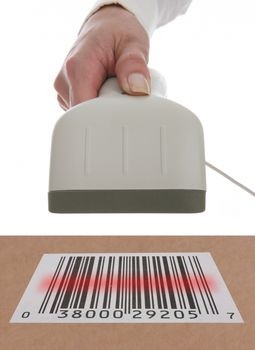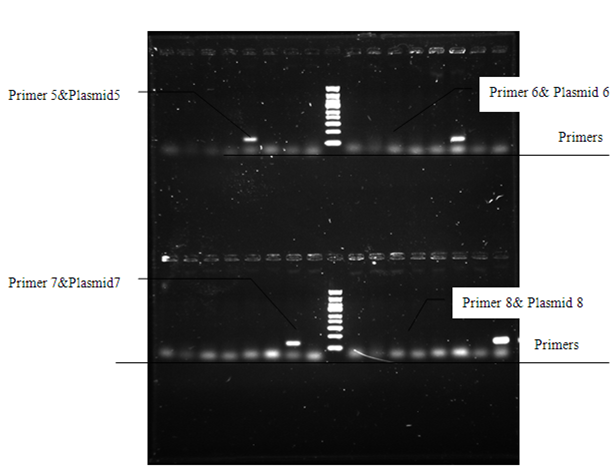Team:USTC/Tool
From 2009.igem.org
Cherrytree (Talk | contribs) |
Cherrytree (Talk | contribs) |
||
| Line 3: | Line 3: | ||
[[Image:barcode.jpg|thumb|right|200px|Barcode & its Scanner]] | [[Image:barcode.jpg|thumb|right|200px|Barcode & its Scanner]] | ||
| - | '''Problem 1:''' | + | *'''Problem 1:''' |
How to distinguish the different biobricks in a biobrick pool in experiment? | How to distinguish the different biobricks in a biobrick pool in experiment? | ||
| Line 10: | Line 10: | ||
We are faced with such a problem to determine the final outputs of E.ADEM (''E.coli'' Automatic Directed Evolution Machine)[https://2009.igem.org/Team:USTC/Project]. An inspiration comes from the supermarket checkout system where thousands of commodities are tagged by barcodes. This universal commercial ID both shortens the check-out time and adds the accuracy. By comparing our problem with this system, what we need to do can be concluded as to design barcodes for biobricks, '''BioBrick-Barcode''', as we call it. | We are faced with such a problem to determine the final outputs of E.ADEM (''E.coli'' Automatic Directed Evolution Machine)[https://2009.igem.org/Team:USTC/Project]. An inspiration comes from the supermarket checkout system where thousands of commodities are tagged by barcodes. This universal commercial ID both shortens the check-out time and adds the accuracy. By comparing our problem with this system, what we need to do can be concluded as to design barcodes for biobricks, '''BioBrick-Barcode''', as we call it. | ||
| - | '''Problem 2:''' | + | *'''Problem 2:''' |
Where is the scanner? | Where is the scanner? | ||
| Line 23: | Line 23: | ||
| - | A set of barcodes under a certain kind of barcode reader has to satisfy its conditions in order to be picked out respectively. For BioBrick-Barcodes, the oligo-sequences must meet several conditions as we considered: | + | *A set of barcodes under a certain kind of barcode reader has to satisfy its conditions in order to be picked out respectively. For BioBrick-Barcodes, the oligo-sequences must meet several conditions as we considered: |
1. Since the BioBrick-Barcodes function as PCR primers, they must satisfy the basic conditions as high-quality primers: | 1. Since the BioBrick-Barcodes function as PCR primers, they must satisfy the basic conditions as high-quality primers: | ||
| Line 34: | Line 34: | ||
b. All of the primers should be specific for the target sequence without combining with other sites. | b. All of the primers should be specific for the target sequence without combining with other sites. | ||
| - | '''Software''' | + | *'''Software''' |
Primer3[http://primer3.sourceforge.net/releases.php] is an open-source primer-design software, and we modified its C codes in parts to design the BioBrick-Barcodes. Since Primer3 is mainly used to pick primers from a DNA template while the BioBrick-Barcodes are supposed to be randomly produced, and a set of BioBrick-Barcodes should be diverse to avoid overlapping PCR, we changed three functions and structure of Primers. | Primer3[http://primer3.sourceforge.net/releases.php] is an open-source primer-design software, and we modified its C codes in parts to design the BioBrick-Barcodes. Since Primer3 is mainly used to pick primers from a DNA template while the BioBrick-Barcodes are supposed to be randomly produced, and a set of BioBrick-Barcodes should be diverse to avoid overlapping PCR, we changed three functions and structure of Primers. | ||
| Line 42: | Line 42: | ||
3. Use the Libray_Mispriming to choose diverse primers. | 3. Use the Libray_Mispriming to choose diverse primers. | ||
| - | '''Experiment''' | + | *'''Experiment''' |
We design a set of ten diverse primers by using the modified software. Apparently, we need to conduct experiments to test its feasibility. | We design a set of ten diverse primers by using the modified software. Apparently, we need to conduct experiments to test its feasibility. | ||
Revision as of 04:47, 21 October 2009
| Home | Team | Project | Modeling | Parts | Standard & Protocol | Software Tool | Human Practice | Notebook |
|---|
Team:USTC/Tool
Contents |
Problem & Solution
- Problem 1:
How to distinguish the different biobricks in a biobrick pool in experiment?
To take a DNA sequencing?---it's costly and time-consuming.
We are faced with such a problem to determine the final outputs of E.ADEM (E.coli Automatic Directed Evolution Machine)[1]. An inspiration comes from the supermarket checkout system where thousands of commodities are tagged by barcodes. This universal commercial ID both shortens the check-out time and adds the accuracy. By comparing our problem with this system, what we need to do can be concluded as to design barcodes for biobricks, BioBrick-Barcode, as we call it.
- Problem 2:
Where is the scanner?
PCR (Polymerase Chain Reaction)[http://en.wikipedia.org/wiki/PCR], which is so conveniently conducted, can serve as the scanner while the primers it needs are the analogue of barcode sequences.
Solution: To check the final outputs in the system of E.ADEM (E.coli Automatic Directed Evolution Machine), we need to design a set of DNA oligo-sequences primers as the barcodes to go through the scanner of PCR and help determining the final evolutionary products.
Design
- A set of barcodes under a certain kind of barcode reader has to satisfy its conditions in order to be picked out respectively. For BioBrick-Barcodes, the oligo-sequences must meet several conditions as we considered:
1. Since the BioBrick-Barcodes function as PCR primers, they must satisfy the basic conditions as high-quality primers:
a. Each primer should be 20-30 nucleotides in length; b. Contain approximately equal numbers of 4 bases, with a balanced distribution of G&C residues; c. Hold a low propensity to form stable secondary structures; d. Forward and reverse primers can work properly together;
2. As a set of barcodes, each of the primers should be perceivably different in order to be identified by the scanner:
a. Any one of the primer cannot lead to the PCR of other DNA sequences(a plasmid with a certain target sequence.) b. All of the primers should be specific for the target sequence without combining with other sites.
- Software
Primer3[http://primer3.sourceforge.net/releases.php] is an open-source primer-design software, and we modified its C codes in parts to design the BioBrick-Barcodes. Since Primer3 is mainly used to pick primers from a DNA template while the BioBrick-Barcodes are supposed to be randomly produced, and a set of BioBrick-Barcodes should be diverse to avoid overlapping PCR, we changed three functions and structure of Primers.
1. Add a function to randomly produce the DNA oligo-sequences which replaced the previous function used to pick
segments from the template.
2. Modified the structure used to store information of each primer.
3. Use the Libray_Mispriming to choose diverse primers.
- Experiment
We design a set of ten diverse primers by using the modified software. Apparently, we need to conduct experiments to test its feasibility.
1.Synthesize the DNA oligo-sequence;
2.Construct plasmids;
3.Conduct a 10*10 cross experiment: Each primer reacts with all the plasmids;
Expectation: only complementary couple leads to PCR results.
Results
In the electrophoretogram, only the combination of primer 5 & plasmid 5, primer 6 & plasmid 6, primer 7 & plasmid 7 lead to PCR results. Along with other electrophoretograms we conclude that this set of primers can be used as a set of barcodes.
| |
Application
- In Synthetic Biology
BioBrick barcodes are a set of artifical DNA parts designed for PCR. They can be used alone as a high-quality PCR primer. Also, they can be used in a group as a convenient tool to identify the biobrick parts just as we do.
- Beyond Synthetic Biology
We create a new software to design PCR primers without a template. The primers chosen from a random oligo-sequences can enlarge the application scope of PCR.
 "
"


